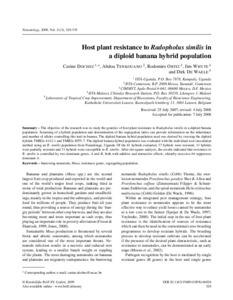| dc.contributor.author | Dochez, C. |
| dc.contributor.author | Tenkouano, A. |
| dc.contributor.author | Ortiz, R. |
| dc.contributor.author | Whyte, J. |
| dc.contributor.author | Waele, D. de |
| dc.date.accessioned | 2019-12-04T11:11:49Z |
| dc.date.available | 2019-12-04T11:11:49Z |
| dc.date.issued | 2009 |
| dc.identifier.citation | Dochez, C., Tenkouano, A., Ortiz, R., Whyte, J. & De Waele, D. (2009). Host plant resistance to Radopholus similis in a diploid banana hybrid population. Nematology, 11(3), 329-335. |
| dc.identifier.issn | 1388-5545 |
| dc.identifier.uri | https://hdl.handle.net/20.500.12478/2504 |
| dc.description.abstract | The objective of the research was to study the genetics of host plant resistance toRadopholus similisin a diploid bananapopulation. Screening of a hybrid population and determination of the segregation ratios can provide information on the inheritanceand number of alleles controlling this trait in banana. The diploid banana hybrid population used was derived by crossing the diploidhybrids TMB2x 6142-1 and TMB2x 8075-7. The diploid banana hybrid population was evaluated with the individual root inoculationmethod using anR. similispopulation from Namulonge, Uganda. Of the 81 hybrids evaluated, 37 hybrids were resistant, 13 hybridswere partially resistant and 31 hybrids were susceptible toR. similis. After chi-square analysis, the results indicated that resistance toR. similisis controlled by two dominant genes,AandB, both with additive and interactive effects, whereby recessivebbsuppressesdominantA |
| dc.description.sponsorship | Flemish Association for Development Cooperation and Technical Assistance |
| dc.description.sponsorship | Directorate-General for Development Cooperation and Humanitarian Aid, Belgium |
| dc.format.extent | 329-335 |
| dc.language.iso | en |
| dc.subject | Burrowing Nematode |
| dc.subject | Musa |
| dc.subject | Resistance Genes |
| dc.subject | Segregating Population |
| dc.subject | Radopholus Similis |
| dc.subject | Bananas And Plantains |
| dc.subject | Pathogen |
| dc.subject | Genes |
| dc.subject | Pratylenchus |
| dc.title | Host plant resistance to Radopholus similis in a diploid banana hybrid population |
| dc.type | Journal Article |
| dc.description.version | Peer Review |
| cg.contributor.affiliation | International Institute of Tropical Agriculture |
| cg.contributor.affiliation | International Maize and Wheat Improvement Center |
| cg.contributor.affiliation | Katholieke Universiteit Leuven |
| cg.coverage.region | Africa |
| cg.coverage.region | Acp |
| cg.coverage.region | East Africa |
| cg.coverage.region | Central Africa |
| cg.coverage.region | North America |
| cg.coverage.region | Southern Africa |
| cg.coverage.region | Europe |
| cg.coverage.country | Uganda |
| cg.coverage.country | Cameroon |
| cg.coverage.country | Mexico |
| cg.coverage.country | Malawi |
| cg.coverage.country | Belgium |
| cg.isijournal | ISI Journal |
| cg.authorship.types | CGIAR and developing country institute |
| cg.iitasubject | Banana |
| cg.iitasubject | Disease Control |
| cg.iitasubject | Food Security |
| cg.iitasubject | Genetic Improvement |
| cg.iitasubject | Handling, Transport, Storage And Protection Of Agricultural Products |
| cg.iitasubject | Livelihoods |
| cg.iitasubject | Plant Breeding |
| cg.iitasubject | Plant Diseases |
| cg.iitasubject | Plantain |
| cg.iitasubject | Plant Production |
| cg.journal | Nematology |
| cg.howpublished | Formally Published |
| cg.accessibilitystatus | Limited Access |
| local.dspaceid | 93255 |
| cg.identifier.doi | https://dx.doi.org/10.1163/156854109X446926 |

